The fungus in the fingers of the legs is a problem that bothers many.The type of skin and nails with itching, ardor and antistics is just a small part of it.The disease is dangerous with complications that are even more difficult to cure.However, it is possible to deal with the problem, if it seriously treats the treatment of fungal infection (mycosis).
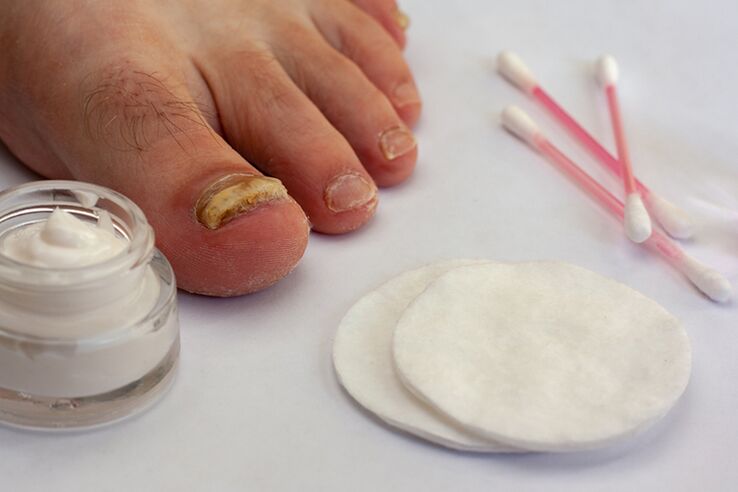
Why does the fungus occur on the feet?
Fungi are one of the types of infectious agents that affect the skin.These are difficult and extremely tenacious microorganisms.Therefore, fungal diseases require a serious and integrated approach to treatment.
Fungi have their favorite habitats in the skin.First, it is the skin of the fingers of the feet and nails.The reason for this is understandable: the feet are usually inside the shoes, within which a lot of humidity and dirt accumulates, as well as very hot.Therefore, fungi living in the feet have a lot of food and a favorable microclimate for spread.Some types of complex fungi often affect the skin, and other types of fungi, for example, yeast and mold, prefer nail plates.Perhaps simultaneous infection with various types of fungi at the same time.
Contribute to fungal development on the fingers:
- reduced local and general immunity;
- poor foot hygiene;
- inconvenient and narrow shoes;
- irregular change of socks or socks;
- use socks or a means of synthetic materials that do not pass the air;
- regular hypothermia or feet overheating;
- circulatory disorders in the legs;
- varicose veins;
- Chronic cardiovascular system diseases, diabetes mellitus;
- a long antibiotic treatment course;
- greater sweat of the legs;
- lack of vitamins and mineral elements in the body;
- Mechanical damage to the skin, calluses, trauma of the feet;
- Excessive physical weight on the legs;
- An irregular nail haircut on the legs.
The most important of these factors are reduced immunity and blood circulation in the legs.A decrease in immunity may occur due to different reasons.In general, these are serious, mainly infectious chronic diseases.In addition, immunity can decrease due to HIV, taking immunosuppressants, with cancer.A violation of blood circulation in the fingers of the legs is no less important for the diseases of blood vessels, blood, diabetes, smoking.
You can develop mycosis to stop in men and women.In adults, they appear more frequently than in children.
Some types of fungi are constantly inhabited in the skin and activate only in adverse circumstances, for example, fungi of the genus Candida.And other species are transmitted from person to person.The infection can occur when visiting the gym, the bathroom, the shower, if at the same time a person does not wear personal shoes.In addition, people who put on the shoes or socks of another person, or allow other people to use them, undergo a significant risk of infection.Often, the infection occurs when the same towels, manicure supplies, etc. are used.The factors that increase the probability of infection are cuts on the skin surface, the deformation of nail plates.
Symptoms of fingers mycosis
The main symptoms of foot mycosis are itching and burning.The redness of the skin, small bubbles, greater peeled and thickening of the skin, can also observe an unpleasant smell.The first symptoms of skin mycosis can be confused with simple irritation, gratitude.
Symptoms of onychomycosis
The fungus can affect not only the skin, but also the nails.The last variety of mycosis is called onychomycosis.The main symptom of onychomycosis is a change in the structure and type of nails, its greatest fragility.The nail becomes yellow, grooves and cracks appear on its surface, the nail plate is thick and deforms.If the treatment is not treated, the nail will gradually be exfoliated from the bed of the nail and collapse.
How do you see the fungus on your finger?
You should not make a diagnosis on your own, through photographs.The diagnosis must be made by a qualified dermatologist.
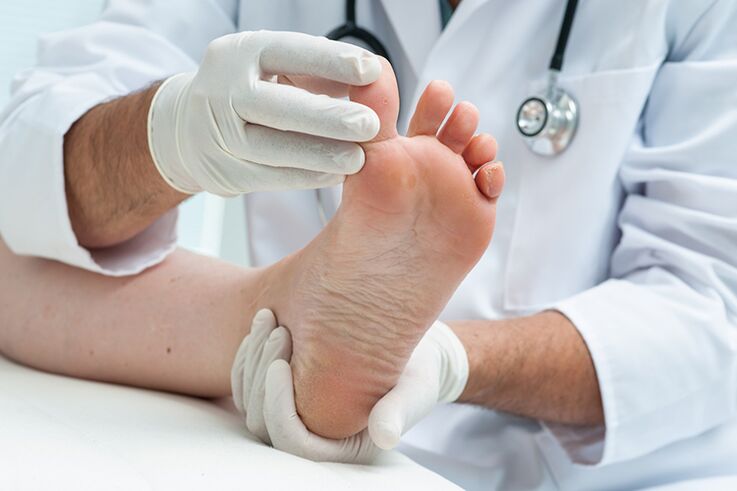
Only he can determine the type of fungus.To do this, it is possible that you not only need an external examination of the feet, but also leather scrape laboratory tests.

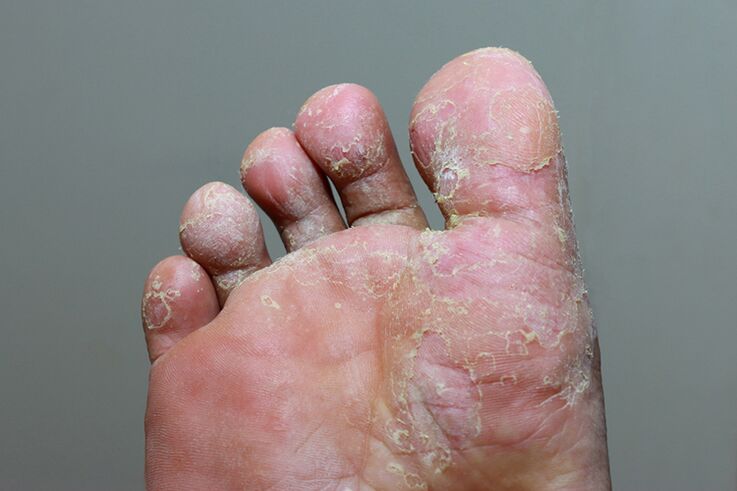
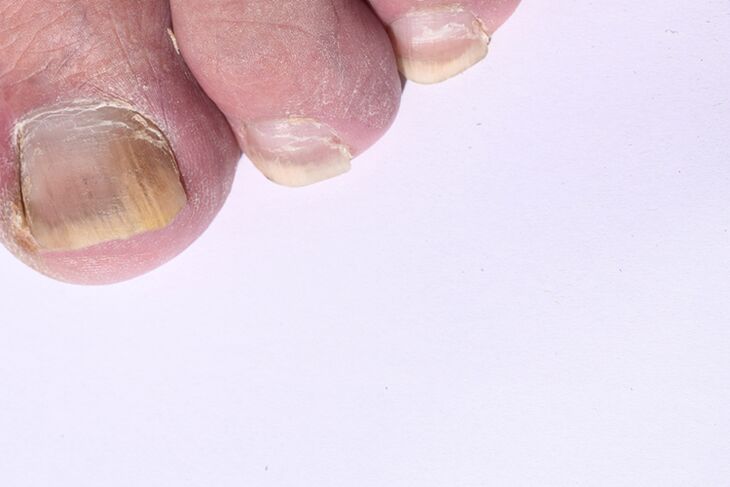
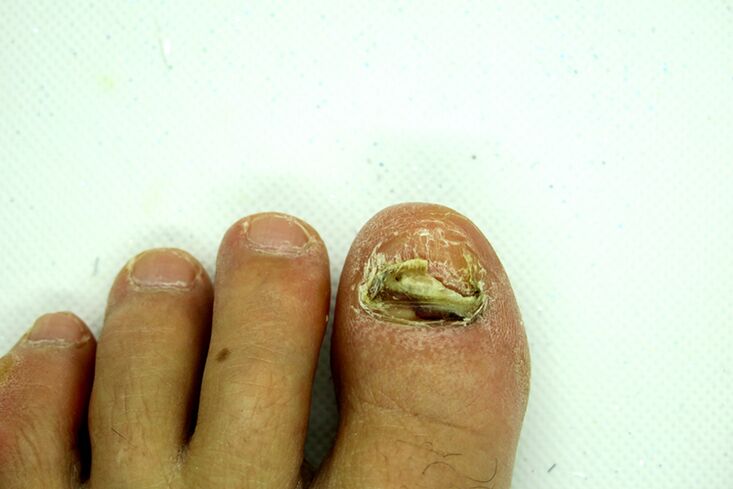
However, the presence of signs, at least remotely similar to the photographs represented in the photographs, is an occasion to worry and see a doctor.
The treatment of the disease is integral and is carried out at home under the supervision of a doctor.
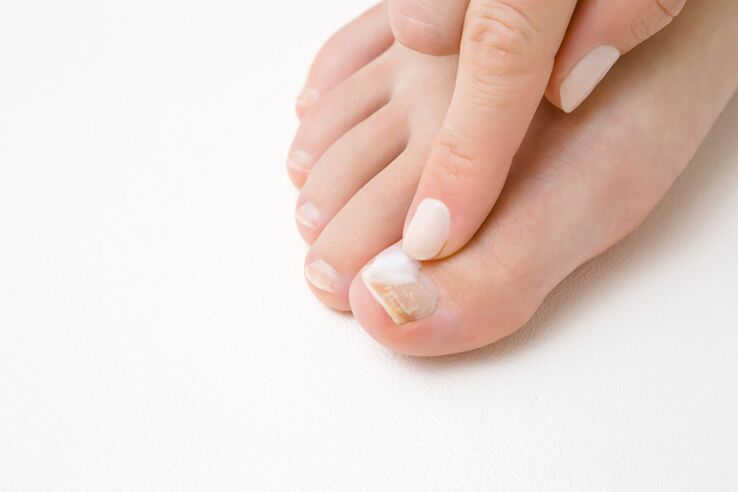
Mushroom on the little finger
The fungus can affect the skin of any foot of the foot.But small fingers in the leg are more vulnerable to infection.The little finger in tight shoes is often compressed, because the skin is rented and blood circulation is altered.With the damage to the finger of the little finger, the disease develops very quickly, faster than in any other nail.When infected with a little finger, the infection can quickly touch other fingers.
The fungus on the little finger is in the same way as the fungus in other areas of the skin.With the onychomycosis of the finger finger, the most rational exit can be the elimination of its nail plate.This operation will not cause many inconveniences to the patient, because the little finger nail grows rapidly.However, although the nail does not grow again (this can take 3-4 months), it is necessary to use antimicotic medications to avoid reinfection.
How to treat the fungus on the fingers?
The treatment of mycosis should begin with the first alarming symptoms.First, you must communicate with a dermatologist for diagnosis.Before starting therapy, it is necessary to establish the fact of the presence of mycosis and the type of pathogenic microorganisms.To this end, the doctor will take a scraping of the skin or cut a piece of nail (with damage to the nail).Blood analysis is donated, blood for sugar.The mycosis of the skin of the feet should be differentiated from:
- other infectious skin diseases;
- allergic reactions;
- Dermatosis caused by diabetes, vascular diseases, stress and nerve diseases.
For the treatment of mycosis in the legs, local products (aerosols, ointments, creams) are used more frequently.Only in severe cases, the doctor can prescribe antimicotic tablets.The most used tablets with fluconazole, itraconazole, terbinafina.
The treatment is based on the use of antifungal agents.This type of drugs contains substances that kill fungi (fungicides) or stop their reproduction (fungistatic).
What antimicotic agents are used more frequently:
- Clotrimazole,
- Ketokonazole,
- Terbinafina,
- Nistatin,
- Mikonazole,
- Atmosphere,
- Fluconazole.
Local medicines with antibacterial, anti -inflammatory and keratolithic properties are also used.Antibacterial agents are prescribed if suppuration occurs, that is, the bacteria joins a fungal infection.Anti -inflammatory medications face unpleasant symptoms: itching and burning.However, they do not affect the cause of the disease: pathogenic microorganisms.Keratolytic agents include zinc, sulfur and sulphuric ointment.They accelerate the regeneration of skin tissues due to the acceleration of the exfoliation of the dead epidermis.
For stop mycosis therapy, bathrooms with antiseptic agents are also used: potassium permanganate solutions, iodine, salt, dietary soft drinks, boric acid.The bathrooms are better before bedtime for 20 minutes.To prevent infection with spores, you must treat healthy areas of the skin with chlorhexidine, iodine, hydrogen peroxide, potassium permanganate.For techomycosis therapy, varnishes with antimicotic substances are used: Locerile, exodéril, Batrophen.These varnishes must be applied to the nail plate.
Ointments and creams should be applied to pre -lavada and clean skin with the frequency indicated in the product instructions.The area of application of the ointment must be slightly larger than the visible damage area.To apply the nail on the nail plate, the nail must be steamed, the unequal edges must be linked with a file and the nail surface must be with a solution that contains alcohol.
In popular medicine, the decoctions of medicinal plants are used to get rid of mycosis in the legs: chamomile, calendula, sage, must of San Juan, mint, vinegar, onion and lemon juices.
What to do if the fungus does not happen with the finger?
The treatment of mycosis is a long and difficult process.Fungal microorganisms are very tenacious, and in a couple of days it is impossible to get rid of them.Sometimes many months of careful therapy are needed.At the same time, it is impossible to interrupt therapy for a single day.The treatment of onychomycosis cannot be completed until a new healthy nail plate grows.
It is also important to consider other factors associated with the development of the disease.Not fulfilling skin hygiene and the optimal feet temperature regime can reduce all therapeutic efforts to zero.This means that it is necessary to regularly wash the surface of the skin of the feet, avoid overheating or hypothermia.It is also important to avoid mechanical damage to the skin, excessive load on the feet, cuts and injuries.Excess weight increases pressure on the feet, so if you suffer fullness, you should think about losing weight.
If the patient constantly wears infected shoes with a fungus, then no powerful medication will help here, because the place of dead microorganisms will immediately occupy new.Therefore, it is necessary to get rid of all the factors that contribute to the infection.You can't go to another person's shoes, socks.Socks should be washed and changed regularly.The internal surface of the shoes must be thoroughly sprayed with anti -inflicted agents.
With stubborn mycosis, it is necessary to analyze the general state of health.Perhaps this will help identify the causes of deteriorated immunity and blood circulation in the legs.Therefore, it is possible to undergo a complete exam and exclude problems with the heart, blood, glasses and organs of the endocrine system.
Finally, it is possible that microorganisms simply develop resistance to the antimicotic agent used.Then it will be necessary to change the drug.Perhaps, systemic antimicotic medications will be necessary in tablets.The dose of drugs should be selected by a dermatologist.
























